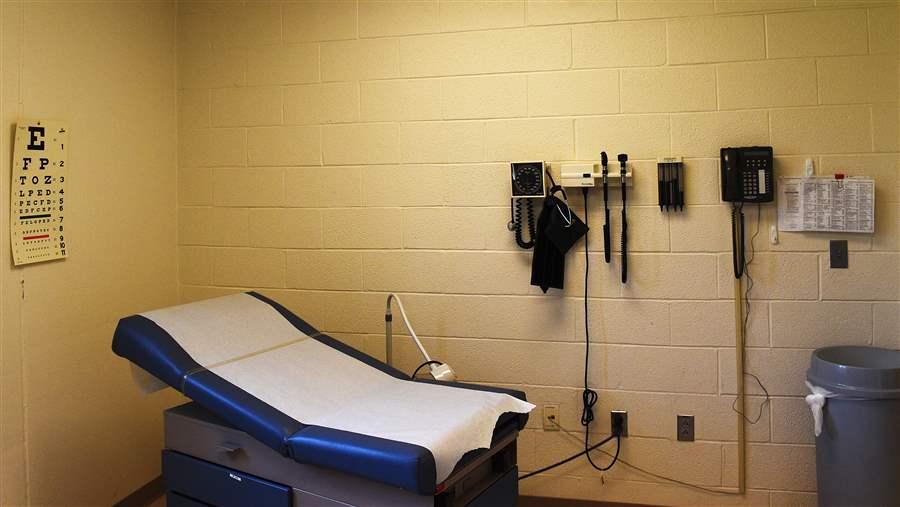Jails: Inadvertent Health Care Providers
How county correctional facilities are playing a role in the safety net

A medical examination room at the Montgomery County Correctional Facility in Boyds, Maryland.
© Astrid Riecken/The Washington Post/Getty ImagesOverview
Every year, millions of people are booked into U.S. jails. During 2015, the latest year for which data are available, there were 10.9 million admissions to these correctional facilities, which hold individuals who are awaiting trial or serving short sentences. The government running the jail—usually a county—has a constitutional mandate to provide people booked into these facilities with necessary health care. Counties designing a jail health care program targeted to meet the needs of their incarcerated population have the opportunity to improve the health of people in jail and the broader community, spend public dollars more effectively, and, in some cases, reduce recidivism.
Yet little is known about how jails administer their health care programs and whether these programs further county public health and safety goals. Research is limited on how counties organize their jail health care services, what care they make available and when, and how they ensure they receive value for their investment in health care. Despite growing awareness of the connection between community services for recently released individuals—especially those with mental illness or substance use disorders, collectively known as behavioral health disorders—and a reduction in recidivism, information about how to achieve this result is scarce.
In an effort to give counties tools to improve delivery of services to an underserved population with high needs, The Pew Charitable Trusts, with the assistance of Community Oriented Correctional Health Services, reviewed 81 requests for proposals (RFPs) for contracted jail health care services and conducted in-depth case studies of three jurisdictions. (See the methodology for more detail.) This research revealed wide variation in the ways that counties arrange to provide health care in their jails and the information they supply to help vendors craft bids. Additionally, despite growing recognition of the health needs of those currently and formerly in jail, our analysis found varying approaches to whether and how jails prepare individuals to manage their health once released.
The research found that:
- Many jails contract with vendors to provide health care. In New York state, for example, 84 percent use vendors to provide at least some health care services. The arrangements that counties make with providers vary; for example, one vendor may be responsible for all services, or a county can use multiple vendors across types of health care services such as mental health and dentistry. Payment models can also vary: While some counties share financial risk for costly medical care with the contractor, others have their vendors assume all risk through a negotiated per-inmate, per-day rate.
- The portion of a jail’s budget spent on health care can vary widely by county. For instance, in Virginia, jails spend anywhere from 2.5 to 33 percent of their budgets on health care.
- Although most jails conduct bookings 24 hours a day, many do not have medical or nursing staff on site to screen incoming individuals at all times. This can lead to delays in identifying and treating acute, possibly life- threatening health problems, and missed opportunities to divert people with behavioral health disorders into treatment settings rather than jail. Jails with an average daily population (ADP) under 500 are less likely to offer round-the-clock clinical services than are larger ones, a situation probably driven by resource constraints.
- Most of the RFPs that were examined look to national accrediting bodies such as the American Correctional Association and the National Commission on Correctional Health Care to guide how the jail offers health care services. Yet few RFPs laid out performance requirements and financial penalties or incentives that would hold contractors accountable for meeting service requirements.
- Many of the documents reviewed did not include all the information potential bidders likely need to propose an appropriate plan for delivering services at a realistic price. By not providing data on the number of people typically requiring care, their average acuity, or the expected staffing required, counties risk receiving bids that fail to meet the needs of those in jail and may not be comparable to each other.
- Because they house a high concentration of individuals with substance use disorders, jails are a key site for providing drug and alcohol treatment. Yet few of the RFPs requested medication-assisted treatment (MAT), a proven method for treating addiction. And of the 11 that did request this service, all but three restricted the use of this treatment option to pregnant women.
- Because jail stays are short on average, the facilities do not have to provide health care to many people for long; their role is more akin to urgent than primary care. Yet incarceration represents both an opportunity to connect an individual with care upon release and a challenge in terms of a possible interruption in treatment upon entry into jail. To address these challenges, Multnomah County, Oregon, has an ambitious pre-release Medicaid enrollment program, while Fayette County, Kentucky, participates in a statewide health information exchange that allows jail health providers to access individuals’ health records dating from before their incarceration. Such care continuity activities can reduce unnecessary and costly emergency room use after release and allow for more efficient and effective care delivery within the jail. For those with behavioral health disorders, connections to care after release are a key part of strategies to reduce recidivism.
The findings show that county jails vary in many ways—from how they pay for their health care to the specific services they offer. Examining these different approaches can help county leaders make more informed choices about how to fulfill jails’ role in the health care safety net, achieve their county public safety missions, and spend taxpayer dollars more wisely.







